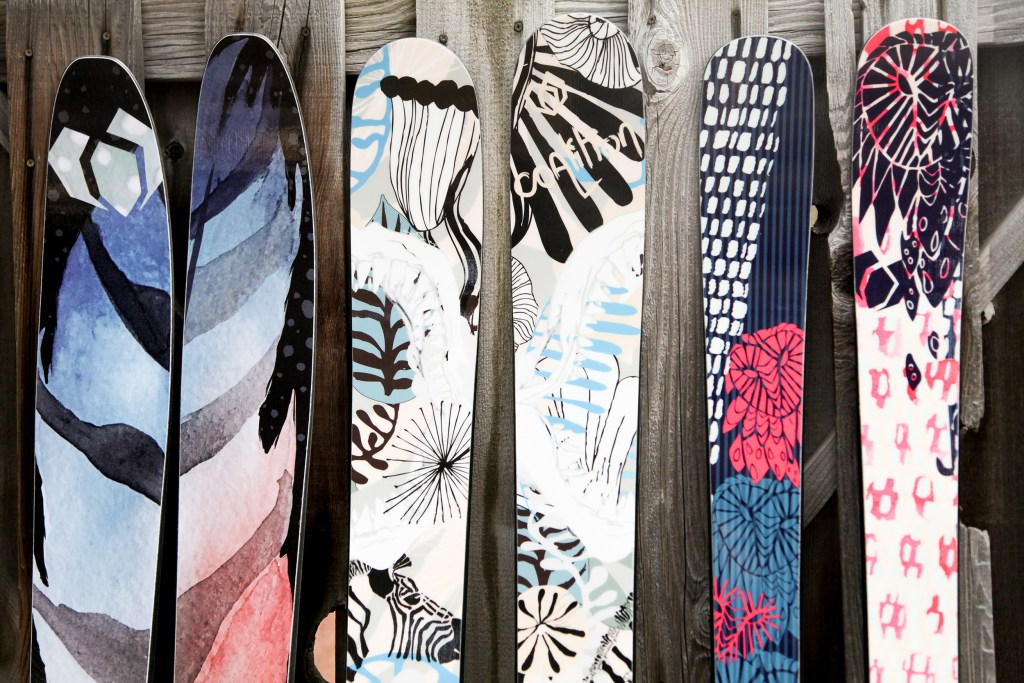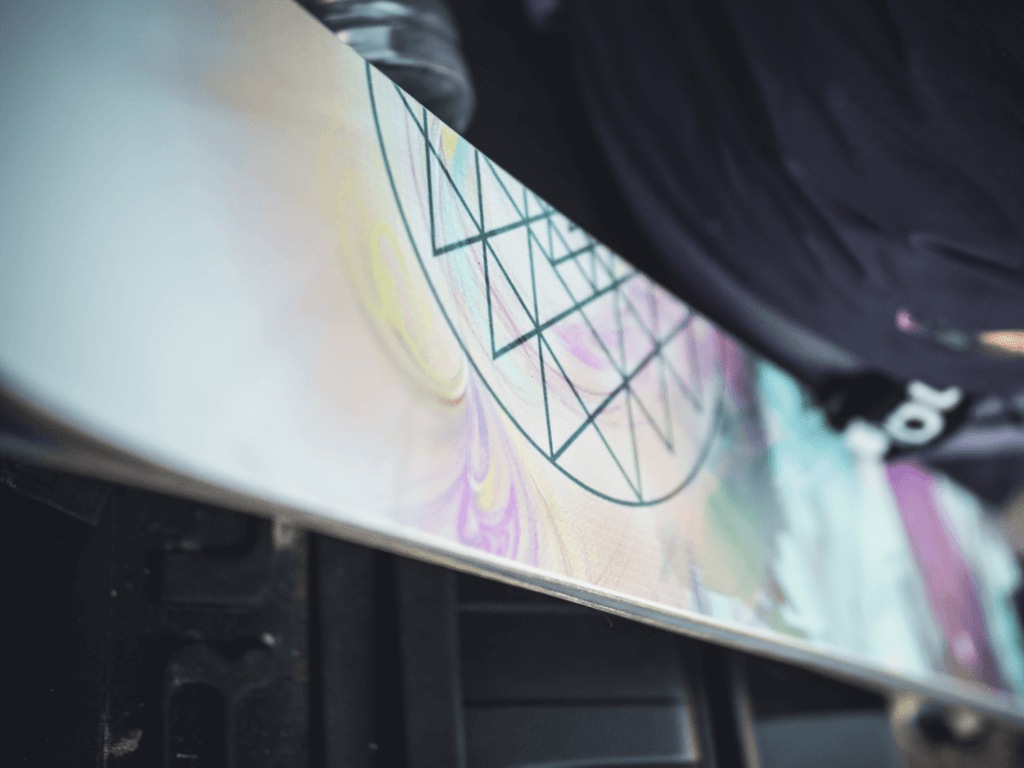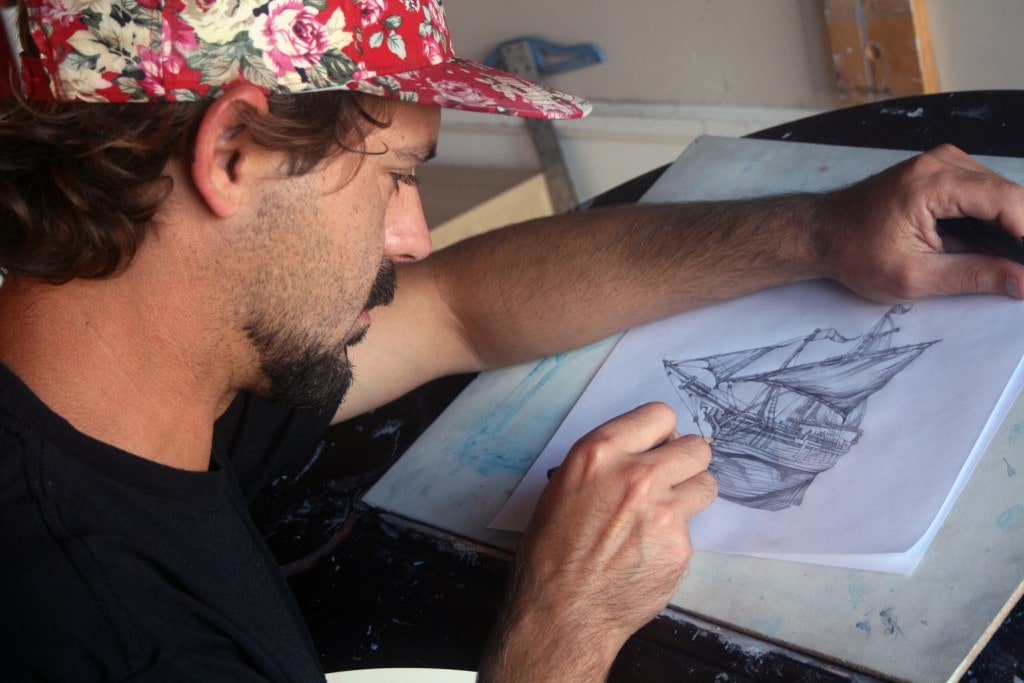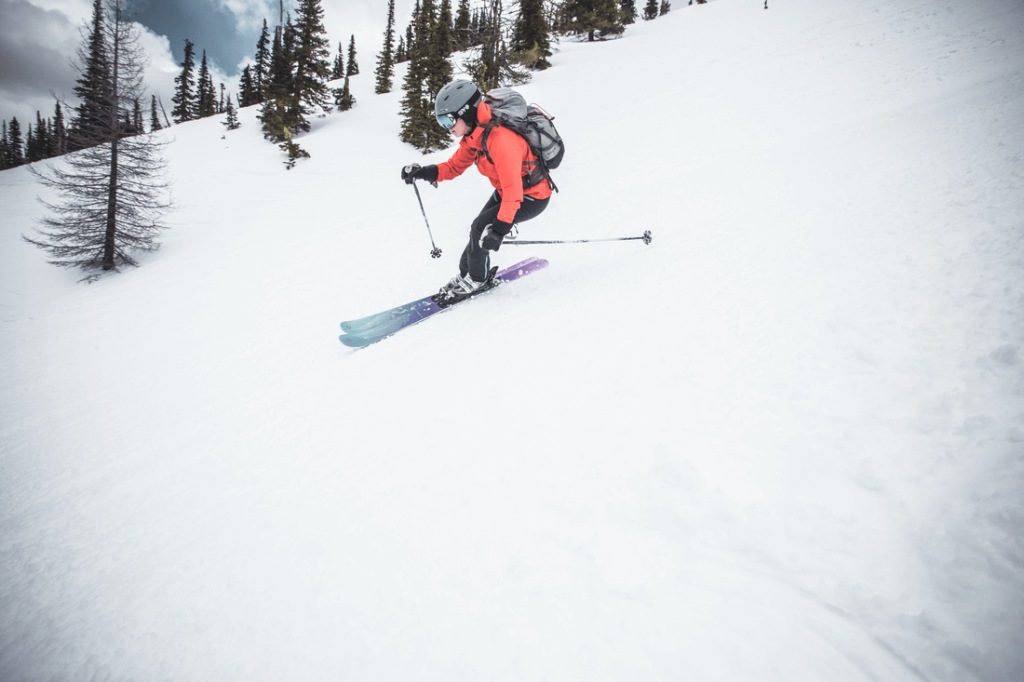In November 2013, Lauren Bello joined a carpool to get from her home in Truckee, California, to a women’s backcountry ski event in nearby Tahoe City. The driver was Jen Gurecki, who happened to be starting a business that would make skis and snowboards for women. As they drove, they talked about their vision for a mountain company.
“Jen wanted to deconstruct and then reconstruct what it means to work and play in the outdoors,” says Bello. “And she wanted to cultivate new voices in the industry.” When Gurecki launched her brand, which she called Coalition Snow, in 2014, she asked Bello, an architect, furniture maker and illustrator who had left the San Francisco Bay Area to work and ski in Tahoe, to become the company’s creative director.

The artwork on Coalition Snow’s 2019 lineup was designed by artist Lauren Bello.
The duo teamed up to build powerful, high-performance women’s skis and snowboards—topped with bold, colorful graphics that Bello designed. Coalition Snow’s products are custom built for women from the core up, but it’s those graphics that really stand out—vibrant floral prints, black and white feathers intertwined with trees and bright, abstract patterns. For this winter, their top-selling ski, called the SOS, is covered in what looks like a stunning underwater forest floor. But do topsheets really sell skis?
“Absolutely, no question about it,” says Jed Duke, the director of product for Blizzard Sport USA. Blizzard’s Black Pearl 88, a women-specific all-mountain ski with feather motifs in a blue and purple color scheme, was the No. 1 selling ski overall during the winters of 2016 and 2017. “People buy with their emotions, and it’s a lot of money to spend. You need to be proud of and happy with what you buy and how it looks.”
Brands take different paths to achieve that connection. For established manufacturers like Blizzard, design parameters often come from the company’s global headquarters. Then they hire creative agencies to develop topsheets based on trends, target customer and intended use—think freeride versus race skis. But in the early 2000s, as independent, boutique ski and snowboard manufacturers began emerging, topsheet graphics became a way to establish a unique brand identity.

Icelantic Skis Maiden 101 skis
Consider the origin story behind Icelantic Skis. In 2004, Travis Parr joined two high school friends in an Evergreen, Colorado, garage to build their own skis. Parr had just finished an illustration degree, and the trio decided he’d create original artwork on canvas, which they’d then scan and convert into topsheets.
“That was a huge difference between us and our competitors,” says Parr. “It was an expression of what we do, taking a hands-on approach through the construction of the ski and the art of it, too.” In the years since, he’s used acrylic and watercolor paints, mixed-media sculptures and pencil or ink to interpret mountain cultures, animals and landscapes for Icelantic topsheets. Thanks in part to that unique branding, Icelantic has gone from a garage-based start-up to an international business with 30 percent growth year over year for the last three years.

Travis Parr works on a design for Icelantic Skis. (Courtesy of Icelantic)
While technology has changed, the essential process remains the same: Three-dimensional artwork becomes a two-dimensional digital file. Bello uses Adobe Illustrator and Photoshop to combine doodles made in a notebook at the coffee shop with the swooping lines of her woodworking projects. Inspiration can be as varied as the hollyhocks in her garden, shed antlers found in the Sierra, and the vivid natural blues and whites of Tahoe winters. The final image must be slightly larger than the ski: often more than six feet long and about 13 inches wide.
“Skis are a tough canvas,” says Bello. “Long and skinny drawings can be hard to conceive. You have to funnel your creativity into a final project with lots of parameters and rules.” That design gets printed on transfer paper, then through sublimation is transferred to a plastic topsheet during the ski construction process. Plus, the artistic process is confined to strict, way-ahead-of-time deadlines: Bello must finish her designs in early fall for the following winter’s product line—over a year in advance of the skis’ release so that factories can produce samples to show dealers and media at seasonal trade shows.
Pro-skier Chris Benchetler works on a different timeline for his Atomic pro-model ski. His 2019 graphics for the Bent Chetler, a surfy powder ski that debuted in 2008, were finished by April 1, 2018. That’s so athlete samples can be produced for summer photo shoots for catalogs printed this fall. Benchetler, a self-taught artist who says he always chooses skiing or rock climbing over sitting down to draw, pulls inspiration for his artwork from his adventures. “The graphics have evolved with me as a person,” he says.

The Blizzard Black Pearl 88 skis in action.
Ski and snowboard topsheets represent a unique challenge: The artwork won’t remain static, or be on walls in museums, galleries or homes. Instead, the creative product heightens an athletic experience in a rugged, outdoor, always-changing natural environment. “The unique style and brighter bases make video and photo content very recognizable,” says Benchetler. “To see the Bent Chetlers everywhere from Japan to East Coast parks because people are into the design or flex pattern is a very humbling, cool experience.”
When Bello leaves her Tahoe office to ski laps at Alpine Meadows, graphics help her engage with women she spots riding on Coalition Snow skis. “The artwork is a fun, easy way to start a conversation,” she says. “Then I talk about the technical aspects of the ski. Our whole company is based on feedback from women on what they want in a ski. That’s the joy of having a small company and being able to engage with humans in the wild.”
